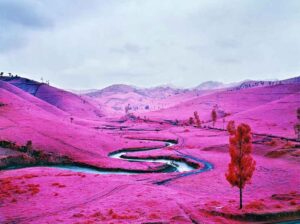Eleonora Schianchi
Entering MAST, one has the impression of being teleported into another dimension, a feeling which might well be shared by anyone seeing this space for the first time. The modern and shiny building, designed by STUDIO LABICS (Rome) in 2005, is the las

Photo: Jack Shainman, 2021
t thing you would expect in an historical and very much lived-in city like Bologna. Inside the complex, 77 photographs in large format, a big video wall and two monumental immersive video installations are spread within the three main exhibition spaces: the MAST Gallery, the Foyer, and Level 0.
Mosse’s interest in social and political conflicts is apparent in his first shots, taken in Bosnia, Kosovo, the Gaza Strip, and on the frontier between Mexico and the United States. He captures the tragedy of these events, but there is something in Mosse’s works exhibited at MAST that resonates and becomes louder at every step forward: the series Infra, Heat Map and Tristes Tropiques show Mosse’s need to stand at a distance from his subjects. A distance that is both physical and conceptual and, as stated by the curator of the exhibition, Urs Stahel, fundamental to “give account of the circumstances, of the context, putting what precedes and what follows at the center of his reflection” (press release). After all, in Displaced we never see the destruction, the ongoing catastrophe, but we know something happened or will eventuall happen.
The constant technology upgrades, non-stop feeds, and instant updates of the postmodern era brought about a perpetual image-exposure that made us oversaturated. This flood of information inevitably pushed documentary photography towards a blind alley that seemed impossible to escape. We are too close, we see too much, we live with skepticism, in a state of anaesthesia.
I was caught by surprise when, while searching information about the artist, I read that he was defined as a “conceptual documentary photographer” in the press release. But wasn’t documentary photography dead? Richard Mosse is determined to relaunch documentary photography, employing new tools and new approaches to upend conventional representations. Using specific devices, some of which were originally made for military purposes, he rewrites the terms of a genre.
When seeing the pictures from the series Infra, one has the impression of seeing coral-coloured imaginary landscapes. Instead, the use of the Kodak Aerochrome film, originally designed to detect the enemy, is an attempt to stress the ongoing state of emergency in the Democratic Republic of the Congo. In Heat Maps, the device is used to underline the anonymity and the shared condition of people in refugee camps. Using a thermal imaging camera, able to detect temperature differences, he calls our attention to mass migrations towards Europe and to the crisis between open and closed borders. Lastly, in his recent Ultra and Tristes Tropiques series, he uses UV fluorescence technique and satellite photography respectively (based on drones and multispectral imaging) to crystallize both the beauty of the Amazon rainforest and the striking impact of deforestation in Brazil.
As suggested by Susan Sontag, “there’s nothing wrong with standing back and thinking” (Regarding the pain of others, ed. Penguin, 2004). Richard Mosse steps back, takes aim and finally re-appropriates this distance through the use of a series of tools that were not created to serve art, but that turn out to be a way to subvert the conventional way of conceiving photography. The impressive size of the works, the immersive video installations and the use of different devices forces us to step back too, to observe at a thoughtful distance. If images “cannot be more than an invitation to pay attention, to reflect, to learn, to examine”, the aim of “Displaced” is precisely for the spectator to feel again that discomfort, that sense of estrangement lost due to the constant exposure to an endless flow of images.
Richard Mosse finally understands that the only way to challenge how we see and perceive images is to establish new visual, conceptual and critical meanings within the images themselves, and within us. This exhibition is a jolt to the system, showing that documentary photography is not dead, and that it might have acquired a new shape.
Richard Mosse’s exhibition is at Fondazione MAST, Bologna, until 19th of September 2021. The entrance to the exhibition is free upon reservation, and open from Tuesday to Sunday, 10 am-8 pm.
Volume 35 no. 6 July/August 2021
